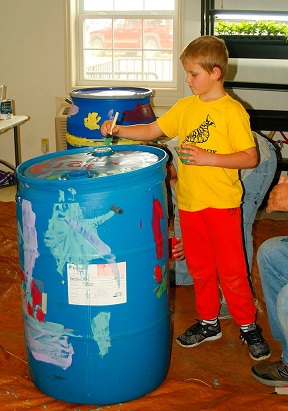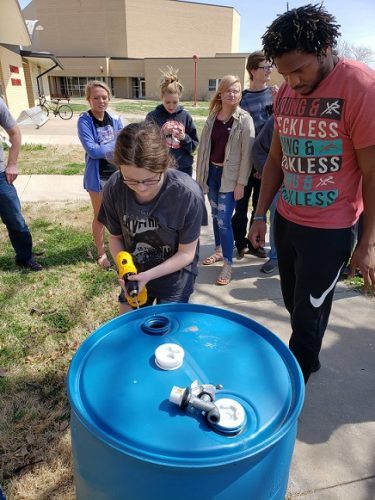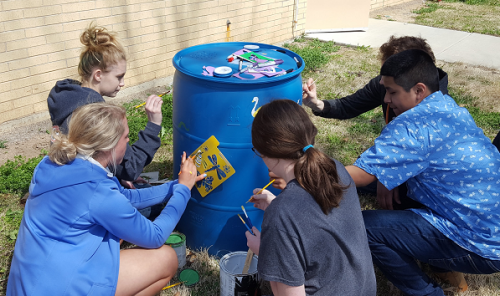Rain Barrels for Water Discovery
The Kansas Wetlands Education Center sits on the edge of the Cheyenne Bottoms, the largest inland marsh in the United States, and a designated Wetland of International Importance. Its 41,000 acres is particularly known for its migratory birds, as well as a rich ecosystem of other flora and fauna.
The center fulfills its mission to educate the public about the importance of wetlands and water resources in a number of ways, including in their relationships with nearby schools, according to program specialist Mandy Kern. Thanks in part to a GreenWorks grant, a combination of rain barrel construction and PLT water-related activities proved to be an effective, fun, and eye-opening way to fulfill the mission.
What’s a Rain Barrel?
A rain barrel collects and stores rainwater from a roof that would otherwise be lost to runoff. Thus, it saves money (by using less purchased water), decreases the impact of runoff, and provides a high-quality source of water for gardening or other non-potable uses.
With a drill and basic building skills, a plastic food barrel can be repurposed into a receptacle that can capture more than 50 gallons of water. With a little paint and some imagination, the sides of the barrel can be transformed into “outdoor art.”
 Rain Barrels for Different Ages
Rain Barrels for Different Ages
The center introduced rain barrels in three distinct settings:
- At Ellinwood Elementary School, fourth and fifth graders made four barrels (two per grade) to place in the school’s outdoor learning center. They had to figure out the best place for them and work with the maintenance department to connect them to existing gutters and equipment.
- At McPherson High School, the rain barrels were used as part of a yearlong PLT GreenSchools partnership with two environmental science classes. In carrying out the GreenSchools Water Investigation, students calculated how much water the small McPherson Unified school district uses in a year (7,879,000 gallons at a cost of $24,381.54!). Students learned how rain barrels could at least partially reduce water usage.
- Finally, the center offered rain barrel construction to families as part of a community Biosphere Block Party, an Earth Day event. More than 100 people worked together to make rain barrels to take home and learn about the advantages of doing so.
 PLT Connections
PLT Connections
“The biggest asset to this project was adding the extra curriculum from PLT resources,” said Mandy Kern. “We didn’t just go in and build a rain barrel with students. They did investigations and learned about water conservation along the way.”
In addition to the GreenSchools investigations, Kern found the PLT activity Every Drop Counts (Activity #28) was useful with both the elementary and high school students. By going from two cups to 1 drop of water, they visually experienced the tiny percentage of the Earth’s water resource that is potable. The high school classes also delved into PLT’s secondary Places We Live activity about the Ogallala Aquifer, especially relevant because McPherson’s water supply comes from the nearby Equus Bed Aquifer.
“Anytime we can get students outside and show a connection to their learning is great,” Kern said. “The activity showed them why they would want to save rainwater and how it could be cost savings for their school and help the environment and help the garden.” She noted a potential extension in the future could be whether plants that used rain versus city water grew differently.
Kern stressed the importance of relationships between nonformal and formal educators. “You can work with the teachers, touch base, ask what they need,” she suggested. “We can help them give their classes that environmental spin. We can show them that we are not taking away from what they want to do, but adding to and enriching their curriculum.”
 One More Thing about Rain Barrels
One More Thing about Rain Barrels
Many online resources provide instructions about how to build a rain barrel, such as this one from Cornell University Extension Service.
One thing to look for when purchasing the barrels that Kern learned the hard way: “Make sure the barrels have removable lids!”


